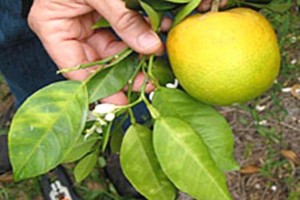By Sean Nealon
A team of scientists, led by a group at the University of California, Riverside, has received a five-year, $5.1 million grant from the U.S. Department of Agriculture to fight a disease that is devastating the citrus industry.
The team will design and identify bactericides–chemicals that kill bacteria–to target Huanglongbing, a bacterial plant disease decimating citrus trees worldwide. They also will focus on better understanding the pathways those bactericides travel inside citrus trees.
Huanglongbing, which has devastated citrus trees in Asia and South America, was detected in Florida in 2005 and has since led to a 75 percent decline in the Florida’s $9 billion citrus industry. Fifteen U.S. States or territories, including California, are under full or partial quarantine due to the presence of the Asian citrus psyllid, an insect which feeds on citrus trees and – in doing so – transmits Huanglongbing, which has been detected in three residential communities in Southern California but not in commercial citrus.
Past research has identified the bacterium (Candidatus Liberibacter asiaticus or CLas) associated with Huanglongbing that is killing citrus trees. But, it has proved difficult to deliver bactericides to the phloem, the part of the citrus tree where the harmful bacteria resides.
The UC Riverside team will analyze phloem transit routes that bactericides take when introduced through common application methods, such as trunk injection or leaf or root applications.
They also will continue to develop a new delivery system for use in field citrus trees. The delivery system targets the branches and petioles, which are the stalk that join a leaf to a stem. The idea is based on previous work that indicates that this is an effective and efficient way to tap into and introduce material into phloem tissue, a tissue that is hard to access.
The researchers will undertake an extension and outreach program for citrus growers and non-commercial citrus growers (homeowners and hobbyists), and they will perform an economic cost-benefit analysis for adoption of these treatments in the commercial citrus industry.



